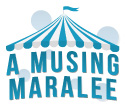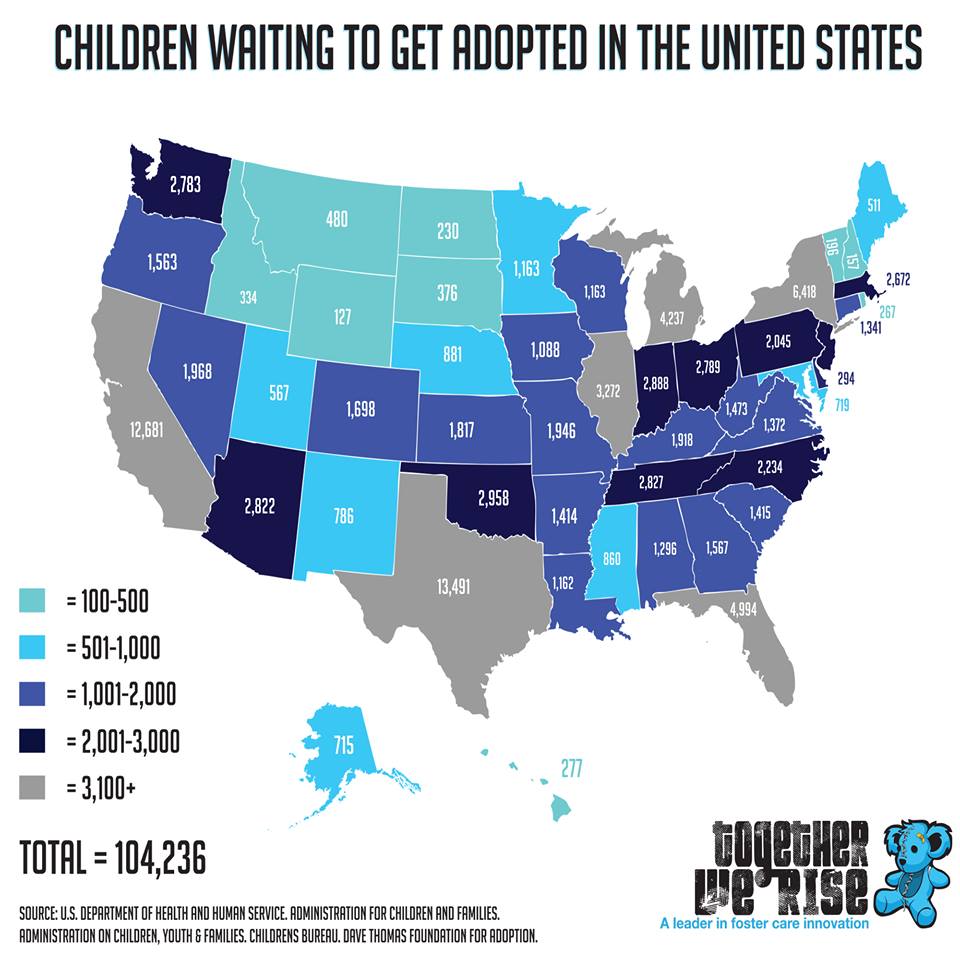Everybody needs to see this map from Together We Rise. It details the number of waiting kids in your state, but I’ve come to realize to really understand this map, you need to understand the geography of foster care. You have to have an awareness of some of the underlying issues behind the numbers represented here. So I want you to see it through my eyes. If you and I were having coffee and you asked me what I thought about it, here’s what I’d want you to know:
-Many of these kids are older, have special needs or are part of a sibling group. If you want to become a family for a child who needs one, educate yourself on the unique issues involved in raising a child who has experienced a level of trauma. By and large, these numbers represent kids who have spent years in the system and are harder to place, otherwise they would have been adopted by their extended families or foster parents.
-These kids were legally orphaned by the government. I just want to let that sink it for a minute. We as a society said that their parents were unfit to raise them, but we provided no alternative for a permanent family. What obligation do we have to be sure they don’t spend the rest of their lives as orphans when WE are the ones that orphaned them?
-Older kids (and adults!) still need families. Just because you turn 18 doesn’t mean you’re prepared to be alone in the world. I certain wasn’t. In my thirties I see how much I still need my mom, my dad, my siblings. They are where I go for advice and comfort. That’s where I spend holidays. Just because you have “aged out” of the system doesn’t mean you ever age out of the need for a family. If you don’t feel like you’re called to deal with all the issues of raising little kids, could you commit to being the support structure for an almost adult who is ready to go out into the world, but still needs a home base?
-Colorado is innovating. I am impressed by the vision and work of Project 1.27 both in Colorado and across the country. They have been working to get churches invested in the work of foster care– both in connecting families with waiting children and in helping educate church communities about how to support foster and adoptive families so they don’t burnout or disrupt. Colorado also has some positive laws that help young children achieve permanency before spending too long stuck in the system. The interplay between legislation and advocacy groups can have a powerful impact on the number of waiting children in a state. If you can’t adopt, you need to be an educated voter about what is happening in your state on behalf of the most vulnerable.
-Most of the kids adopted from foster care were never represented by these numbers. My kids were never “waiting” children. They were foster kids, then they were adopted by us with no lag time in between (other than a waiting period/filing papers time). Sometimes people think they can’t adopt infants or toddlers from foster care because they don’t see those kids among the “waiting” children. Those kids DO get placed in families, but they are placed with foster families that then are willing to adopt them if they become adoptable. If you want to work with those kids and their families, you have to be willing to take on the risks of foster care.
-Adoptions across state lines are complicated. There are lots of reasons why kids who are adoptable in one state have a hard time getting placed with a qualified, loving, waiting family in another state. The Interstate Compact on the Placement of Children is one of the reasons. It’s just an extra level of paperwork and bureaucracy to make sure kids are being protected and state laws are being followed between both the sending and receiving state. It adds time and extra documentation to the process. There are also funding issues that are above my pay grade to discuss (states receive federal money to incentivize adoptions, adoption subsidies get more complicated across state lines, etc.). The short story is that adoptable children often get stuck in their home states even if there isn’t a family available for them there. It’s frustrating.
-ICWA is a thing. The Indian Child Welfare Act is meant to preserve a Native American child’s right to grow up within their own culture. Because there are more waiting Native American children than there are Native American families wanting to formally adopt (although informal adoption is much more common), those kids may age out of foster care without receiving a family. Not every number represented in this map of “waiting” children actually represents a child that just any family could adopt. This is why we need a diversity of families to be licensed and ready to take placements.
-Wendy’s Wonderful Kids is a great organization. Not only do they make delicious frosties, but the people at Wendy’s are passionate about adoption. The Wendy’s Wonderful Kids program specifically works to find families for the kids represented by these numbers. Check them out.
-Compare the number of churches in your state to the number of waiting children. You can do that here. Prepare to feel embarrassed at how lightly we are taking the command to care for orphans. What if each church committed to one child, one family. What if they decided to provide support, help connect people with services, provide respite as needed? What if the church didn’t delegate caring for foster kids to the state or even to just the foster families in their congregations, but what if they saw it as the mission of the church to love these kids well? What a difference that could make.
-If you want to see the faces of your state’s waiting children, check out The Heart Gallery. Here you can find information about the kids who need families and how you can help.
-WOULD SOMEONE PLEASE ADOPT DAVID? This child came from the same orphanage as my son, which means he has been orphaned twice in his life. This is unacceptable. I will keep doing my best to find this young man a family for as long as I keep seeing his beautiful face on the Nebraska Heart Gallery website. If you’re interested in being a family for David and local to me here in Nebraska, I would love to talk to you about how my family could be a support for you as you make this decision. We can’t adopt him, but we’ll do what we can to help whatever family is able to.
Not every child represented by the numbers on this map will be able to safely live with your typical family. But there may be a child here who needs YOU and exactly what your family has to offer. None of us can singlehandedly change the world of foster care, but we absolutely can change the world for one of these kids who has been wounded by the system.


7 Comments
Leave a reply →